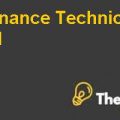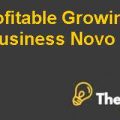
Introduction:
Tom.com was launched in 1996 with the joint ownership of Cheung Kong Group and Hutchison Group. Initially, metroradio.com was their first website for online information of Metro Radio. The financial society was attracted by Tom.com after the publication of its initial public offer because the association of Li family with Tom.com because of the sound financial history. It was a challenge to create expert judgment on such investment. Valuations of internet companies have always been a highlighted matter because of the uncertain nature of industry and rapid rate of innovation on internet market. Following are the key success factors of successful internet companies.
ü Technology is the first cutting edge of any successful internet company. Therefore, competent research and development department along with highly professional employees are hired.
ü Strong financial position is the guaranty of future investment to capture market share. To gain leading position in the industry to secure the future.
ü It is a key practice of successful internet companies to search for strategic alliance and always value the exceptional mind.
Being the most populous market and one of the future economic leaders, China is the most attractive market for internet companies according to the source of government officials of China as there was 0.74 percent internet penetration in China.
Tom.com’s marketing strategy was to target three market segments of Chinese market and International market with the support of three types of customized products and services. For the people of China “Lifestyle for Chinese”, and for non-Chinese speaking audience, “China experience” finally both types of substance to foreign nationals. At the initial stage, Tom.com is operated by five key operational units.
Tom.com’s decision of IPO to float 15 percent of its stock at propose price of HK$1.63 per share to generate fund of about HK$640 million to finance the capital expenditure so as to acquire better technology to increase market share through better marketing and promotional activities.
Problem Statement
The problem was that Internet companies were difficult to evaluate using the discounted cash flow approach. Consequently, different valuation approaches such as net asset valuation approach, adjusted present valuation approach, discounted valuation approach and implied growth model approach are used in evaluation of the companies. But for this particular case, the valuation approach that will be the best to value the Tom.com; hence, it will be determined that either this approach is optimally best approach to value the Tom.com and that this approach optimally determines the value of the Euro global stock of the Tom.com or not.
Valuation
For the case of Tom.Com there were different valuations approaches that were used to evaluate the companies, which were operating in the internet business. Evaluations were made to analyze using these approaches that identify which model is the most optimal valuation approach for the internet industry. After quantitative analysis of both the valuation models, firstly the implied growth valuation model and secondly discounted cash flow model; a conclusion was made on the basis of the below given analysis that the implied growth valuation model was best for internet organizations. To support this approach, different valuation models that were used are analyzed below:
The Implied Average Annual Growth Rate Approach
Growth and expected growth are necessary methods of valuation on the basis of sales and profits. In the book “The Internet Bubble” written by Perkins; these two methods are examined. During the tenure of five years of hyper growth, Perkins estimated the expected growth rates of International organizations, based on some assumptions.
Two sets of assumptions are used by Perkins; first assumption is for the future implementation of Internet organizations and second is for required rate of return. Exhibit Implied Growth in Excel shows the calculation with assumptions.
The Perkins estimated that current investors will require 15% to 25% for every penny of return for their venture. The following assumptions are made for calculation of Implied Growth Rate:
Assumptions:
Risk free rate and market risk premium were implicated to 6% with the given range of beta 1.8 for the period 2000 to 2004 and for the period 2005 to 2009, it was taken as 0.5. At HKD 1.63 for a share, the IPO would generate proceed of HKD 4.6 billion to finance market capitalization. To understand that sort of return, the market capitalization of Tom.com in five years would need to be HKD 5.34 billion to HKD 5.8 billion. The Perkins likewise accepted that in three years average P/E multiple of Internet organizations would be 40 times, net revenue would be 5% to 15% and rate of dilution would be 5%. Based upon the Perkins' assumptions, the average income of Tom.com in three years would be HKD 9.3 billion to HKD 7.4 billion. This reflects a normal income development of 100% to 208% for the following three years from HKD 51.7 million in 1999...............
This is just a sample partial case solution. Please place the order on the website to order your own originally done case solution.













